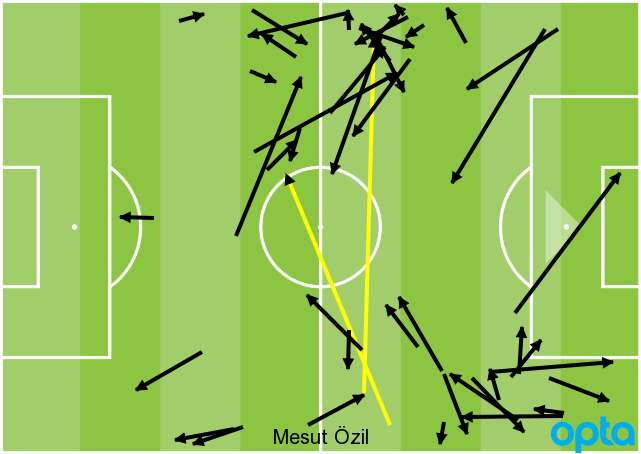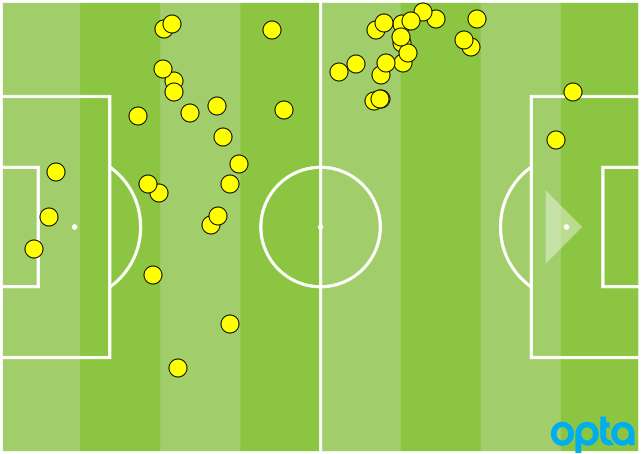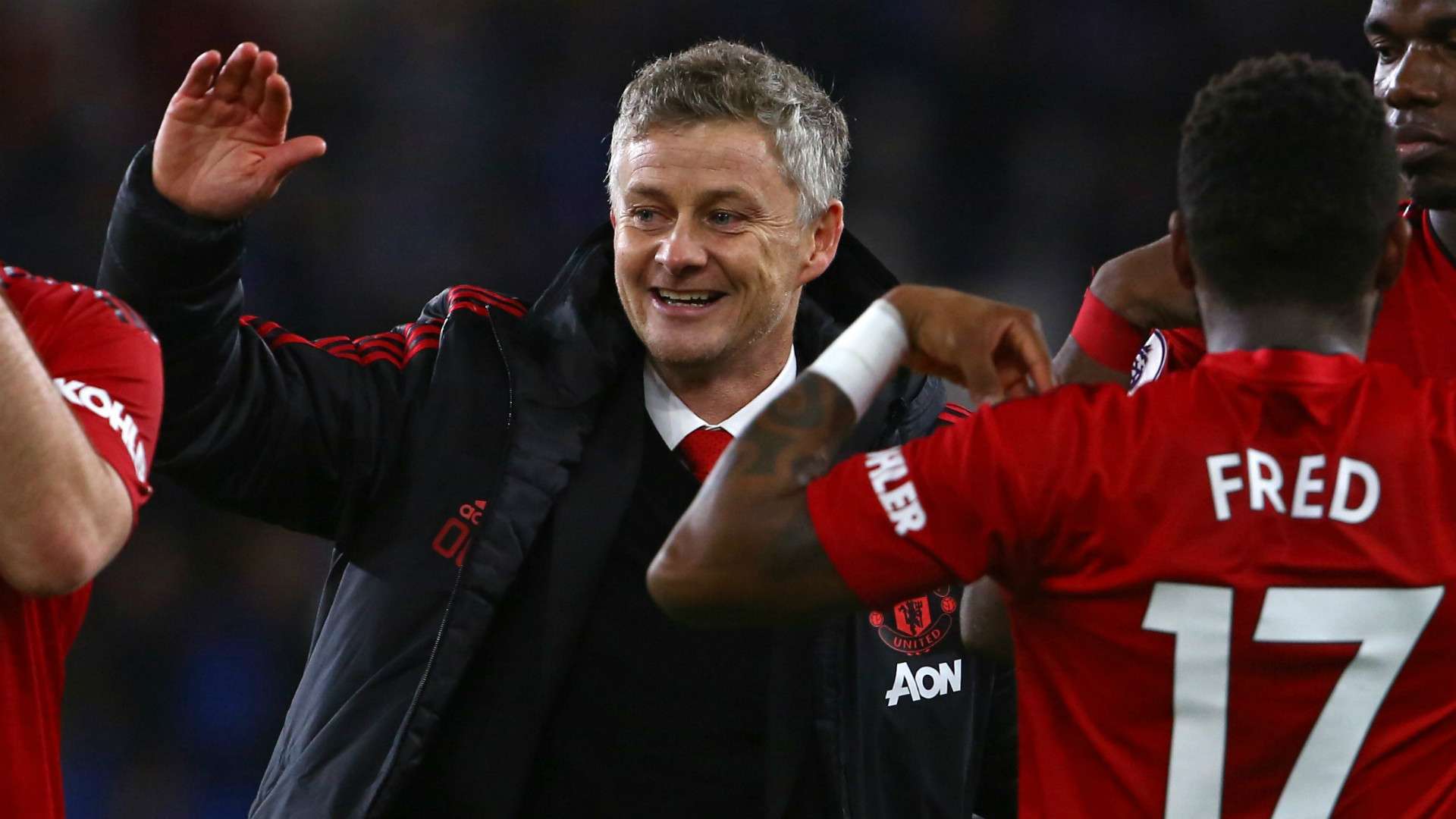When Liverpool went four points clear of Manchester City on Friday night, not even the most optimistic Reds supporters expected the lead to last more than 24 hours.
But Crystal Palace’s surprise tactical victory at the Etihad Stadium was evidence not only of Liverpool’s ability to push the champions all the way, but of Man City’s increasing vulnerabilities.
Elsewhere on a narrative-heavy weekend of football, Leicester City reminded us why they should play counter-attacking football more often with victory at Chelsea, while Manchester United got off to a flying start under Ole Gunnar Solskjaer thanks to his bold commitment to attacking football.
Here are five tactical things you might not have noticed from the weekend’s Premier League action...
Solskjaer's risk-taking unleashes Man Utd's wild side
Solskjaer’s first game in charge of Man Utd was characterised by quick forward passes, energetic movement, and - above all - risk-taking.
They played with great bravery and creativity, charging around with the joy of prisoners unshackled after an unexpected revolution. Victor Lindelof’s one-two and run into the final third typified their aggressive attacking game, and although the increase in forward-thinking football was largely psychological, Solskjaer deserves credit for his tactical decisions.
Their possession was meaningful, minimising the defenders’ time on the ball and using narrow wingers to create multiple short-passing options in the centre of the park. Marcus Rashford operated like a false nine at times, dropping very deep to link with Jesse Lingard and Anthony Martial as they drifted infield.
United had clearly been told to move the ball as quickly as possible with one or two-touch football. A big feature of their game was forwards dropping off and tapping a one-touch pass back where it came from, dragging defenders out of position and keeping the ball moving.
Ander Herrera was notably improved, his ability to play clever passes under pressure helping United to get beyond the first line of the press and play expansively in the Cardiff half. The Spaniard’s neat, weaving interplay will become a crucial aspect of Solskjaer’s football ,as will the performances of Nemanja Matic. He cleverly dropped in between the two centre-backs when appropriate, which allowed United to spread wider and get the full-backs further forward.
They will face tougher tests than this, but it was very encouraging to see Solskjaer recognise that the fluidity, intelligence, and positional interchanging of Martial, Rashford, and Lingard is United’s greatest asset.

Leicester are back, but Puel could still be moved on
Ordinarily a big win at Stamford Bridge would provide security for a manager on the brink, but Claude Puel may in fact have hastened his own demise on Saturday.
Leicester’s 1-0 victory at Chelsea was reminiscent of their title-winning campaign – suggesting the Foxes should be led by a counter-attacking manager, rather than one set on prosaic possession football.
Leicester sat in a hunched shell, accruing just 28 per cent possession, to stop Chelsea from passing the ball through the centre of the pitch.
It worked well. The vast majority of Jorginho’s passes went sideways to the wingers, who, with no other option, promptly swung crosses into the box (36 in total, a season high for Chelsea). Unsurprisingly, Wes Morgan and Harry Maguire easily dealt with these.
It was classic Leicester, a reminder of how well the team – and Jamie Vardy in particular – could be playing.
The former England striker has struggled to fit into Puel’s usual system but was back to his old self on Saturday, chasing down long balls and scoring the winner from a quick break.
Elsewhere, Ricardo Pereyra’s and James Maddison’s tendency to run with the ball also proved well-suited to a counter-attacking philosophy.
Ozil proves his worth with intelligent display
Unai Emery is getting a reputation for strange tactical choices at the beginning of matches.
It was certainly odd to line up against such a narrow team as Burnley in a 4-3-1-2 formation, with Mesut Ozil expected to create chances for the two strikers in a No. 10 role.
Unsurprisingly, Sean Dyche’s defensive shell held out through the centre, although ultimately they were beaten thanks to Ozil’s reading of – and adaptation to – the game.
For a central attacking midfelder Ozil spent a remarkable amount of time on the flanks, his pass map revealing a performance that could be called a “false ten”.
He drifted into channels on the outside of Burnley’s narrow four-man midfield, linking neatly with wing-backs Sead Kolasinac and Ainsley Maitland-Niles to ensure Arsenal’s possession dominance never became aimless.
Ozil played a crucial role in the early opening goal, without which the match could easily have swung the other way. His cross to Kolasinac was special, but from a tactical perspective his involvement in the build up down the right was just as important.
Within 15 minutes on Saturday it was clear that Ozil is a better option for Arsenal than Henrikh Mkhitaryan.
 Opta
Opta
PIC: All Ozil's passes vs Burnley (Black = successful)
Stones struggles underline City's Fernandinho reliance
Pep Guardiola has been guilty of too much squad rotation in recent weeks, culminating in Saturday’s 3-2 defeat to Crystal Palace in which only five of his starting 11 could be considered first choice.
Injuries have played their part, but this weekend he had three of his best players on the bench, plus he decided to replace Fernandinho with John Stones when he had the manpower necessary to avoid such an unusual move.
It was no surprise Nicolas Otamendi struggled against the speed of Palace’s breaks, while Stones was directly at fault for two of Palace’s goals.
What makes Fernandinho so unique for a defensive midfielder is his agility and technique; without him, City’s expansive formation meant Palace could counter in the spaces around the flat-footed Stones.
His poor mobility saw him turned in the build-up to the first two Palace goals, first failing to properly tackle James McArthur before Jeffrey Schlupp fired in a equaliser, and then losing his man in the move that led to Palace’s free-kick from which Andros Townsend gave the away side the lead.
Fernandinho remains an under-rated component of this City team and, judging by Saturday’s game, arguably the only irreplaceable player in Guardiola’s team.
Hodgson out-tactics Guardiola to stun City
By contrast, Roy Hodgson’s midfield selection was perfect.
Schlupp played in central midfield for perhaps the first time in his career, the plan being to inject some counterattacking directness into the centre without losing defensive sturdiness.
Schlupp consistently burst beyond Ilkay Gundogan and Stones - most notably to score Palace’s first goall - often moving into a wide left position to double up with Max Meyer.
Schlupp’s selection meant Hodgson switching from 4-4-2 to 4-5-1 with Townsend moving to the right wing, a clever tweak from the former England manager that exploited City’s historic weakness on this side.
Townsend’s cutting infield drew City in, creating space for Aaron Wan-Bissaka to drive directly at Fabian Delph - who has always struggled to defend one-on-ones. It was Wan-Bissaka’s burst past Delph that led to Palace’s match-winning penalty.
 Opta
Opta
PIC: All Schlupp's touches vs Palace
